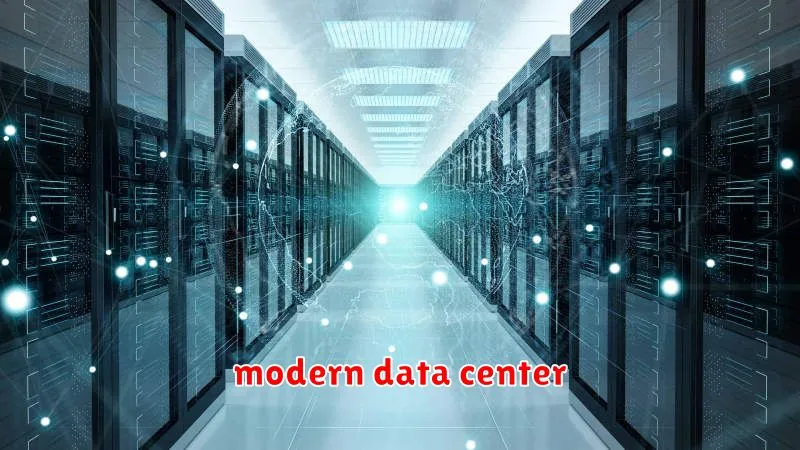In today’s digital landscape, data is the lifeblood of every business. With the ever-increasing volume and complexity of data, organizations are facing significant challenges in managing their data centers effectively. The traditional model of data center management is no longer sufficient to meet the demands of modern businesses. To ensure optimal performance, reliability, and scalability, organizations must adopt innovative strategies and leverage cutting-edge solutions. This article will delve into the modern data center, exploring the key considerations for effective management and highlighting the latest trends and advancements that are transforming the data center landscape.
From cloud computing to edge computing, artificial intelligence to the Internet of Things (IoT), the modern data center is evolving rapidly. Organizations are increasingly adopting hybrid and multi-cloud approaches, requiring a more flexible and adaptable infrastructure. To navigate this complex environment, data center managers must embrace a comprehensive approach that encompasses automation, optimization, security, and sustainability. By leveraging the right tools and technologies, organizations can streamline operations, reduce costs, enhance performance, and ensure business continuity in the face of ever-increasing data demands.
The Evolving Role of Data Centers in the Digital Age
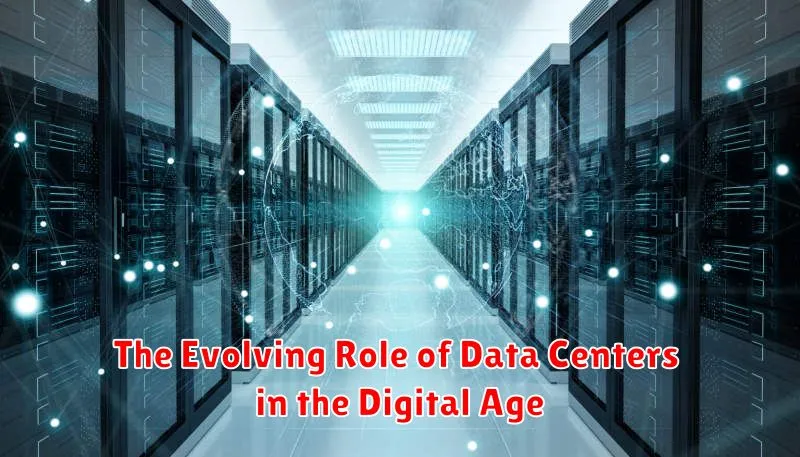
In the ever-evolving landscape of the digital age, data centers have undergone a remarkable transformation, evolving from mere storage facilities to the very backbone of our interconnected world. No longer confined to static, on-premises infrastructure, data centers are embracing a dynamic and adaptable approach, driven by the insatiable demand for speed, scalability, and resilience. The modern data center is no longer just a repository of information; it is a complex ecosystem of technologies, services, and strategies that power our digital lives.
The rise of cloud computing has significantly impacted the role of data centers. Organizations are increasingly moving away from traditional, on-premises infrastructure towards cloud-based solutions, which offer greater flexibility, cost efficiency, and agility. This shift has spurred the emergence of hyperscale data centers, massive facilities that house the computing power and storage capacity needed to support the global cloud ecosystem. These hyperscale centers are characterized by their immense size, sophisticated automation, and advanced energy efficiency measures.
Furthermore, the advent of edge computing has introduced a new dimension to data center operations. Edge data centers are smaller, localized facilities located closer to users and devices, enabling real-time data processing and low-latency applications. This distributed approach allows for faster data delivery, improved performance, and enhanced user experiences. The integration of edge computing with cloud-based solutions creates a hybrid data center model, offering organizations a flexible and scalable approach to data management.
The evolving role of data centers extends beyond technological advancements. The focus on sustainability and environmental responsibility has become paramount. Data centers consume significant amounts of energy, and reducing their carbon footprint is a critical concern. Data center operators are implementing innovative strategies, such as using renewable energy sources, optimizing cooling systems, and adopting energy-efficient hardware, to minimize their environmental impact.
The modern data center is a dynamic and transformative force in the digital age. Its evolution is driven by technological innovation, changing user demands, and a growing emphasis on sustainability. As we continue to navigate the complexities of the digital world, data centers will play an increasingly critical role in shaping our interconnected future.
Key Challenges in Data Center Management
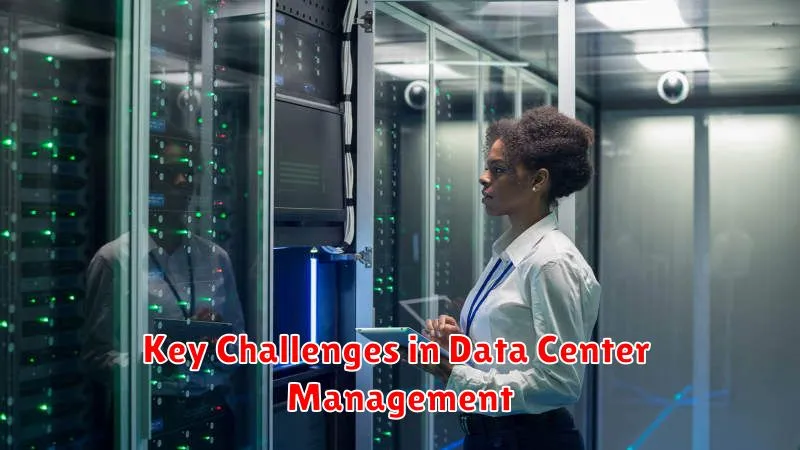
In today’s digital age, data centers are the lifeblood of businesses, enabling operations, storing vital information, and driving innovation. However, managing these complex environments comes with its own set of key challenges that demand thoughtful strategies and innovative solutions.
One of the biggest hurdles is ensuring high availability and reliability. Data centers must operate around the clock, with minimal downtime. This requires robust infrastructure, redundancy, and proactive maintenance to prevent outages and minimize disruptions.
Another critical challenge is managing energy consumption. Data centers are notorious energy guzzlers, and reducing their environmental impact is a major concern. Organizations must implement strategies to optimize power usage, invest in energy-efficient technologies, and explore renewable energy sources.
The rapid growth of data and the increasing demand for computing power also present a challenge. Scaling capacity to meet these demands while maintaining performance and cost efficiency requires careful planning and investment in adaptable infrastructure.
Furthermore, security threats are a constant concern. Data centers are prime targets for cyberattacks, and organizations must employ robust security measures to protect sensitive data and prevent unauthorized access.
Lastly, managing the complexity of modern data centers is a significant challenge. With diverse technologies, interconnected systems, and a constant need for updates and upgrades, effective management requires specialized skills and a comprehensive approach.
Addressing these challenges is essential for successful data center management. Organizations must embrace innovative solutions, leverage automation, and adopt a proactive and holistic approach to ensure the optimal performance, reliability, and security of their data centers.
Optimizing Infrastructure: Power, Cooling, and Space

In the realm of modern data centers, optimizing infrastructure is paramount to ensuring efficient operations and maximizing performance. This involves meticulously managing power consumption, cooling systems, and space utilization to achieve optimal results.
Power optimization is crucial for reducing energy costs and minimizing environmental impact. Implementing strategies such as using energy-efficient servers, adopting virtualization technologies, and optimizing power distribution systems can significantly reduce power consumption.
Cooling systems are essential for maintaining optimal operating temperatures within the data center. Implementing efficient cooling solutions, such as air conditioning systems, water-based cooling systems, and heat exchangers, can effectively dissipate heat generated by servers and other equipment.
Space optimization involves maximizing the utilization of available space within the data center. Utilizing modular data center designs, employing density optimization techniques, and implementing efficient cable management practices can help maximize space utilization and reduce overall footprint.
By effectively optimizing infrastructure, data centers can achieve significant improvements in energy efficiency, operational costs, and environmental impact. Implementing these strategies is crucial for ensuring a sustainable and efficient data center environment.
Automation and Orchestration: Streamlining Operations
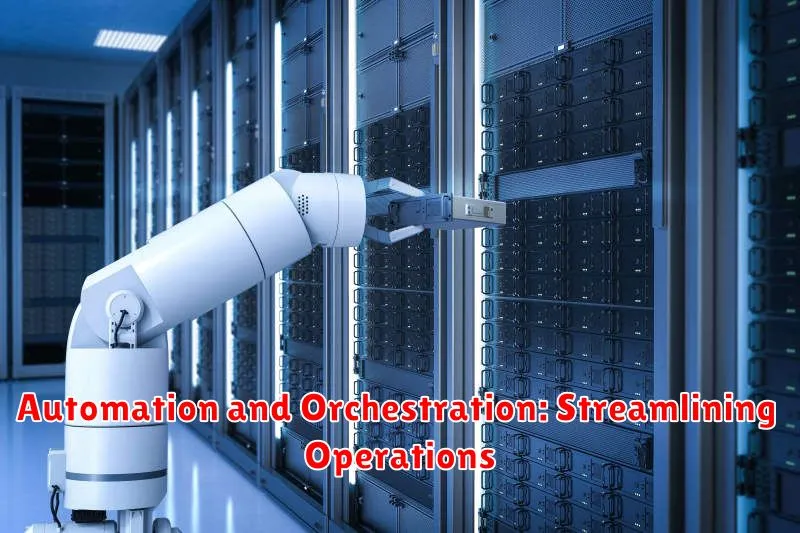
In today’s fast-paced digital landscape, data centers are under immense pressure to deliver high performance, scalability, and reliability. Traditional manual processes are simply not equipped to handle the complexity and speed required. This is where automation and orchestration come into play, revolutionizing data center operations and enabling organizations to achieve unprecedented levels of efficiency and agility.
Automation refers to the use of software tools to automate repetitive tasks, reducing manual effort and eliminating human error. This can encompass a wide range of activities, including server provisioning, software deployment, configuration management, and security updates. By automating these processes, data center teams can free up valuable time and resources to focus on more strategic initiatives.
Orchestration takes automation a step further by providing a centralized control plane for managing and coordinating complex, multi-step workflows. Orchestration platforms allow organizations to define and execute automated workflows that involve multiple components, services, and resources across the entire data center infrastructure. This enables seamless integration and streamlined operations, ensuring that everything runs smoothly and efficiently.
The benefits of automation and orchestration are undeniable. They lead to:
- Increased efficiency: Automation eliminates manual tasks, freeing up staff to focus on higher-value activities.
- Improved scalability: Orchestration platforms allow for rapid scaling of resources to meet changing demands.
- Enhanced reliability: Automated workflows reduce human error and ensure consistent execution of critical processes.
- Faster deployment: Automation and orchestration enable rapid deployment of new applications and services.
- Reduced costs: By streamlining operations and improving efficiency, automation and orchestration can significantly reduce operational costs.
In conclusion, automation and orchestration are essential for modern data centers, enabling organizations to streamline operations, enhance efficiency, and achieve unprecedented levels of agility. By embracing these technologies, data center teams can overcome the challenges of today’s digital landscape and pave the way for a future of seamless, reliable, and high-performing infrastructure.
Security Considerations: Protecting Critical Assets

In the modern data center, where critical business operations, sensitive data, and valuable intellectual property reside, security takes center stage. Protecting these assets from threats both internal and external is paramount. This requires a multi-layered approach, encompassing physical, network, and application security measures.
Physical Security
The foundation of data center security lies in physical access control. Implementing robust physical security measures, such as:
- Access Control Systems: Restricting entry to authorized personnel only.
- Surveillance Systems: Monitoring activity within the data center.
- Environmental Controls: Maintaining optimal temperature and humidity levels to safeguard equipment.
Network Security
Securing the network infrastructure is equally crucial. Implementing a comprehensive network security strategy involves:
- Firewalls: Blocking unauthorized access to the data center network.
- Intrusion Detection and Prevention Systems (IDS/IPS): Identifying and mitigating potential threats.
- Network Segmentation: Isolating sensitive data and systems from the rest of the network.
Application Security
Protecting applications and their underlying data is vital. This involves:
- Secure Coding Practices: Implementing robust security measures within application code.
- Vulnerability Scanning: Identifying and addressing security vulnerabilities.
- Data Encryption: Protecting sensitive data in transit and at rest.
Data Backup and Disaster Recovery
Ensuring business continuity and data resilience requires comprehensive data backup and disaster recovery plans. This involves:
- Regular Backups: Creating regular backups of critical data to multiple locations.
- Disaster Recovery Planning: Establishing procedures for restoring data and systems in the event of a disaster.
- Data Replication: Replicating data to remote locations for redundancy.
Security Awareness Training
Educating employees about security best practices is essential. Implementing security awareness training programs helps employees understand and mitigate security risks.
In conclusion, securing critical assets in the modern data center is a multifaceted endeavor. By employing a layered security approach encompassing physical, network, and application security measures, organizations can effectively protect their valuable data, applications, and infrastructure.
Monitoring and Performance Management
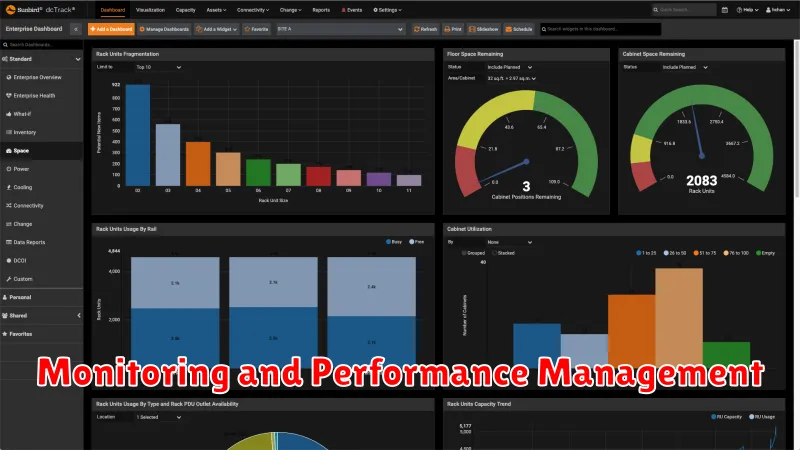
In the modern data center, where complex infrastructure and demanding applications coexist, effective monitoring and performance management are paramount. These systems are not just about detecting issues; they are the foundation for optimizing resource utilization, enhancing service availability, and ensuring business continuity. This article will explore key strategies and solutions for modern data center monitoring and performance management.
Real-time Visibility and Proactive Monitoring
The core of effective monitoring lies in achieving real-time visibility across all critical components of the data center. This includes everything from physical infrastructure like power and cooling to virtualized resources, applications, and network performance. Proactive monitoring involves establishing thresholds and alerts for potential problems before they impact operations.
Advanced Analytics and Automation
Modern data centers leverage advanced analytics to identify trends, predict performance bottlenecks, and optimize resource allocation. Machine learning algorithms can analyze vast datasets to uncover hidden patterns and proactively address potential issues. Automation plays a crucial role in responding to alerts, initiating remediation actions, and even optimizing resource provisioning based on real-time performance data.
Unified Dashboards and Reporting
Comprehensive reporting and centralized dashboards provide a unified view of the data center’s health and performance. This allows administrators to gain insights into key metrics, track performance over time, and make informed decisions about capacity planning and resource allocation. Unified dashboards also facilitate collaboration among different teams involved in data center management.
Cloud-Based Solutions
Cloud-based monitoring and performance management platforms offer several advantages for modern data centers. They provide scalability, flexibility, and access to a wide range of features without the need for extensive on-premises infrastructure. These platforms also facilitate integration with other cloud services and applications.
Capacity Planning and Scalability
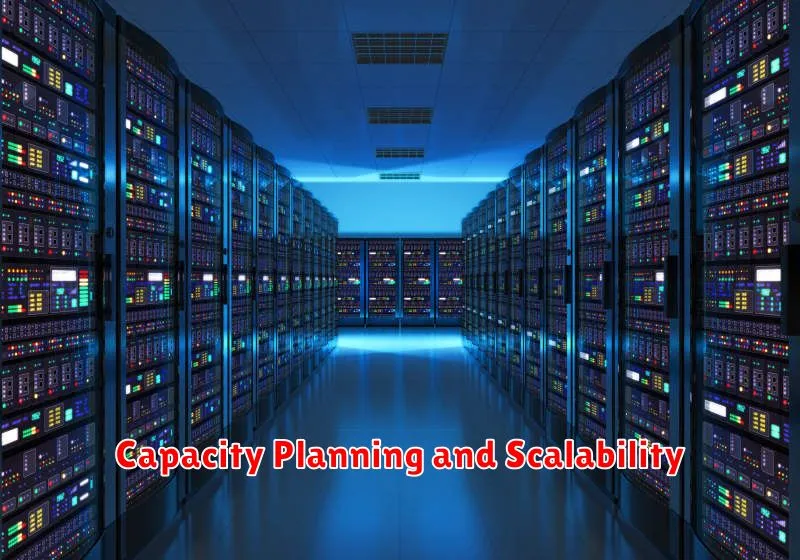
In the modern data center, capacity planning and scalability are paramount to ensuring seamless operations and meeting ever-growing demands. Effective capacity planning involves accurately forecasting future resource requirements, while scalability refers to the ability of the infrastructure to adapt and expand to accommodate those needs. This balance between predicting future requirements and ensuring flexibility is crucial for organizations to maintain optimal performance and avoid costly downtime.
Capacity planning requires a thorough analysis of current resource utilization, historical trends, and projected growth. By analyzing these factors, organizations can anticipate future needs and plan for appropriate infrastructure investments. This includes considerations such as server capacity, storage space, network bandwidth, and cooling systems. A well-defined capacity planning strategy helps prevent over-provisioning, which can lead to wasted resources, and under-provisioning, which can result in performance bottlenecks and service disruptions.
Scalability is equally important, as it allows the data center to adapt to fluctuating workloads and unexpected spikes in demand. A scalable infrastructure can be easily expanded or contracted to accommodate changes in business requirements. This flexibility is essential for organizations that experience rapid growth or seasonal variations in workload. Technologies such as cloud computing and virtualization enable organizations to achieve high levels of scalability, allowing them to add or remove resources on demand.
The interplay between capacity planning and scalability is key to ensuring a data center’s efficiency and resilience. By accurately predicting future needs and designing a scalable infrastructure, organizations can optimize resource utilization, minimize operational costs, and maintain uninterrupted service delivery. As data centers continue to evolve and adapt to the ever-changing demands of the digital world, prioritizing capacity planning and scalability will be critical to achieving long-term success.
Disaster Recovery and Business Continuity

In today’s digital age, data centers are the lifeblood of organizations, driving critical business operations and storing invaluable information. Ensuring the resilience and continuity of these data centers is paramount, and disaster recovery (DR) and business continuity (BC) strategies are crucial components of effective management.
Disaster Recovery (DR) focuses on the ability to restore IT systems and data in the event of a disaster. This involves having backup systems, redundant infrastructure, and well-defined recovery procedures to minimize downtime and data loss. DR plans should be comprehensive, covering various scenarios such as natural disasters, hardware failures, cyberattacks, and human error.
Business Continuity (BC) goes beyond technology recovery. It encompasses the overall ability of an organization to maintain essential business operations during and after a disruption. This includes plans for communication, employee safety, and customer service, ensuring that business processes can continue uninterrupted.
Effective DR and BC strategies require a multi-faceted approach:
- Data Backup and Recovery: Implementing robust data backup and recovery solutions is essential. This includes regular backups, off-site storage, and testing of recovery processes.
- Redundant Infrastructure: Deploying redundant infrastructure, such as multiple data centers, servers, and network connections, provides failover capabilities in case of failures or disasters.
- Business Impact Analysis (BIA): Conducting a BIA identifies critical business functions, dependencies, and potential risks, helping to prioritize recovery efforts.
- Testing and Training: Regular testing and training of DR and BC plans ensure that employees are prepared and processes are functional.
- Cloud Solutions: Cloud-based services offer scalability, flexibility, and disaster recovery capabilities, providing a robust platform for business continuity.
By implementing comprehensive DR and BC strategies, organizations can mitigate the impact of disruptions, minimize downtime, and safeguard their critical business operations. A proactive and well-planned approach ensures resilience, continuity, and the ability to navigate challenges in today’s unpredictable environment.
Cloud Integration: Hybrid and Multi-Cloud Strategies

In today’s dynamic IT landscape, organizations are increasingly embracing a mix of on-premises and cloud environments. This hybrid and multi-cloud approach offers flexibility, scalability, and cost optimization but also presents unique challenges in terms of management and integration. This article will explore strategies and solutions for effectively integrating cloud services into your modern data center.
Hybrid Cloud Integration involves connecting on-premises infrastructure to public cloud services. This strategy allows businesses to leverage the benefits of both worlds. For instance, they can use cloud services for bursting capacity during peak demand or migrate specific applications to the cloud for cost savings. Effective hybrid integration requires careful consideration of connectivity, security, and data management.
Multi-Cloud Strategies extend this concept further by utilizing multiple public cloud providers. This approach provides greater flexibility and resilience, as businesses can distribute workloads across different platforms, mitigating vendor lock-in and ensuring redundancy. However, managing multiple cloud environments presents complexity. Organizations need robust tools and processes to orchestrate and monitor resources across these platforms.
Key considerations for cloud integration:
- Security: Ensuring data security across different environments is paramount. Implementing robust security protocols, identity and access management (IAM) solutions, and encryption strategies is essential.
- Data Management: Managing data consistency and accessibility across hybrid and multi-cloud environments requires comprehensive data management strategies, including data replication, synchronization, and governance policies.
- Connectivity: Reliable and high-performance connectivity is crucial for seamless integration. Organizations should invest in network infrastructure that can handle the increased data traffic and latency challenges.
- Cost Optimization: Understanding and managing cloud costs across multiple environments is essential for achieving ROI. Leverage cloud cost management tools and implement cost-effective usage strategies.
- Automation and Orchestration: Automating tasks and orchestrating resources across hybrid and multi-cloud environments significantly reduces manual effort and improves efficiency.
By adopting a well-defined cloud integration strategy, organizations can unlock the full potential of hybrid and multi-cloud environments. Implementing robust solutions for security, data management, connectivity, cost optimization, and automation will enable them to manage their modern data centers effectively and achieve their business goals.
Emerging Trends in Data Center Management
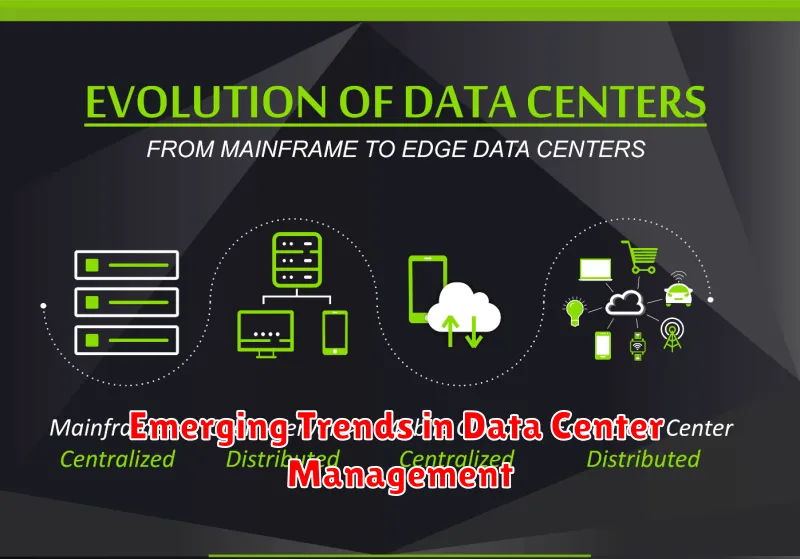
The modern data center is evolving rapidly, driven by a confluence of technological advancements, changing business needs, and the increasing importance of data. To stay ahead of the curve, data center managers must adopt new strategies and solutions to optimize performance, reduce costs, and ensure business continuity. This article will explore some of the key emerging trends in data center management.
Edge Computing
Edge computing is rapidly gaining popularity as organizations seek to reduce latency, improve performance, and enhance security. By moving data processing and storage closer to the source of the data, edge computing can deliver significant benefits for applications that require real-time insights and low latency, such as IoT devices, autonomous vehicles, and streaming services. Data center managers must consider how to integrate edge computing into their existing infrastructure and manage the complexities of a distributed computing environment.
Cloud-Native Technologies
Cloud-native technologies, such as containers and microservices, are revolutionizing application development and deployment. These technologies enable greater agility, scalability, and efficiency, making it easier to build and manage modern applications. Data center managers must adopt a cloud-native mindset and embrace tools and technologies that support this approach. This can involve adopting containers, Kubernetes, and serverless computing solutions.
Artificial Intelligence (AI) and Machine Learning (ML)
AI and ML are transforming data center management by automating tasks, optimizing performance, and improving security. AI-powered solutions can analyze data from various sources, identify patterns, and make recommendations to optimize resource utilization, predict failures, and enhance security. Data center managers must explore how AI and ML can be applied to their specific needs, such as predictive maintenance, capacity planning, and anomaly detection.
Sustainability and Energy Efficiency
Sustainability is becoming increasingly important for data centers, as organizations face pressure to reduce their environmental footprint. Data center managers must prioritize energy efficiency initiatives, such as using renewable energy sources, optimizing cooling systems, and implementing power management strategies. This trend is also driven by rising energy costs and the need to demonstrate corporate social responsibility.
Data Center Infrastructure as Code (DCIaC)
DCIaC involves using code to define and manage data center infrastructure, enabling automation, consistency, and reproducibility. This approach allows for faster deployment, reduces errors, and improves scalability. Data center managers can leverage tools such as Terraform and Ansible to automate the provisioning and management of infrastructure, ensuring consistency across environments.
Conclusion
The data center landscape is constantly evolving, and data center managers must embrace new trends to remain competitive. By adopting edge computing, cloud-native technologies, AI and ML, sustainable practices, and DCIaC, organizations can optimize their data centers for performance, efficiency, and resilience in the modern digital world.

